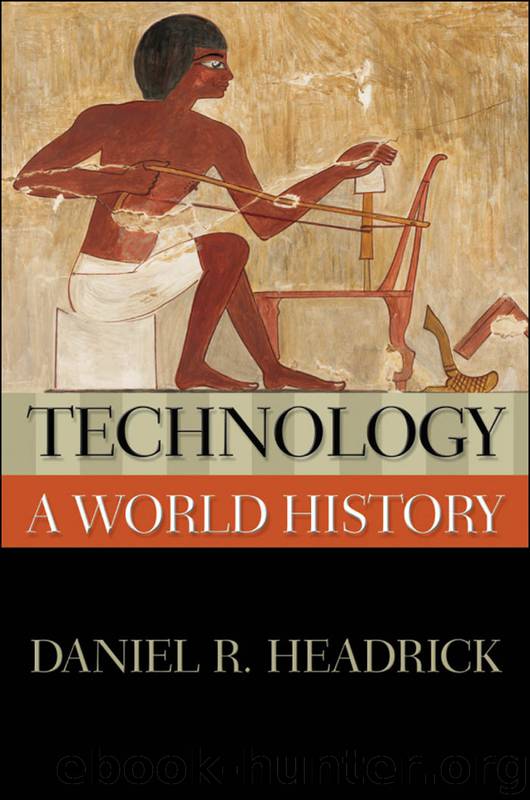Technology by Headrick Daniel R.;

Author:Headrick, Daniel R.; [Headrick, Daniel R.;]
Language: eng
Format: epub
ISBN: 9780195156485
Publisher: Oxford University Press
Published: 2009-03-14T14:00:00+00:00
The Gutenberg Bible, the first large book printed with movable type, came from the Mainz print shop of Johann Gutenberg in the mid-1450s. It was printed on a wooden press, possibly modeled on a wine press, using cast metal type. The handmade paper was imported from Italy. Library of Congress LC-USZ62-51844 and LC-USZ62-87341
These technologies—ships and navigation, firearms, paper and printing—were not adopted everywhere, nor were their effects the same in all places. Instead, they favored one civilization, that of Europe, over the others. Thanks to their naval and military technologies, Europeans made their presence felt around the world from the late fifteenth century on. China, once the most innovative civilization, saw its technology fall behind that of Europe. Likewise in the Middle East, the pace of technological innovation also slowed down. How can we explain these differing rates of technological change among cultures that were in frequent contact with one another? This is one of the questions that historians find most difficult to answer.
Why did the rate of innovation in Asia slow down? The simple answer is the Mongols. These nomadic herdsmen were trained to fight on horseback from early childhood. They were also quick to adopt the most effective weapons and tactics and to recruit skilled technicians from among their settled neighbors. From 1220 to 1260, they conquered both the Middle East and China in the most rapid expansion of any empire in history. And everywhere they went, they sacked and burned cities, killed hundreds of thousands of captives, destroyed irrigation works, and ruined once-fertile land.
After the brief but destructive Mongol interlude, Arab civilization, once brilliant and innovative, became cautious and conservative. Muslim clergy resisted such innovations as mechanical clocks and printing. The Turks, who controlled the Middle East after the Mongols, kept abreast of advances in land warfare until the late eighteenth century but neglected naval shipbuilding and metallurgy and showed little interest in agricultural innovations.
Today, Westerners think of technological innovation as the key to economic growth, a rising standard of living, and national security. The Chinese had a different experience. The remarkable innovations and the flourishing economy of the Song dynasty did not protect them from the Mongols. After their defeat, China was ruled by an alien people who brought in other foreigners like Marco Polo to help them govern. After the Ming expelled the Mongols in 1368, the Chinese began to associate technological innovations and foreign ideas with defeat and humiliation.
To be sure, it was after expelling the Mongols that the Ming dynasty, a purely Chinese regime, sent out their great expeditions. But that was the personal project of the Yongle emperor, and it was quickly reversed by his successors. Because China had a single ruler whose word was law, the history of Chinese technology was particularly sensitive to the whims of whoever sat on the throne.
To administer their empire, the Ming rulers appointed mandarins, men who obtained their positions by passing examinations in classical Chinese culture. They barely tolerated military leaders and despised merchants and craftsmen, the people most interested in technology.
Download
This site does not store any files on its server. We only index and link to content provided by other sites. Please contact the content providers to delete copyright contents if any and email us, we'll remove relevant links or contents immediately.
Learning SQL by Alan Beaulieu(6079)
Weapons of Math Destruction by Cathy O'Neil(5927)
Digital Minimalism by Cal Newport;(5459)
iGen by Jean M. Twenge(5215)
Sapiens by Yuval Noah Harari(5163)
The Age of Surveillance Capitalism by Shoshana Zuboff(4036)
Elon Musk by Ashlee Vance(3898)
Thing Explainer by Randall Munroe(3814)
Apollo 8 by Jeffrey Kluger(3539)
Future Crimes by Marc Goodman(3411)
The Science Book (Big Ideas Simply Explained) by DK(3158)
Who Can You Trust? by Rachel Botsman(3038)
I Live in the Future & Here's How It Works by Nick Bilton(2863)
Infinite Energy Technologies by Finley Eversole(2853)
Steve Jobs by Walter Isaacson(2777)
Dawn of the New Everything by Jaron Lanier(2698)
The Innovators: How a Group of Hackers, Geniuses, and Geeks Created the Digital Revolution by Walter Isaacson(2597)
Chernobyl by Serhii Plokhy(2450)
Ben Franklin's Almanac by Candace Fleming(2399)
